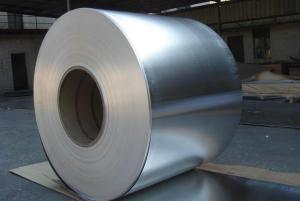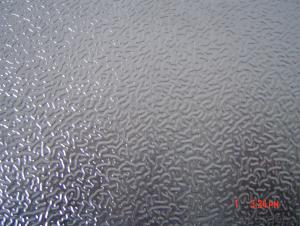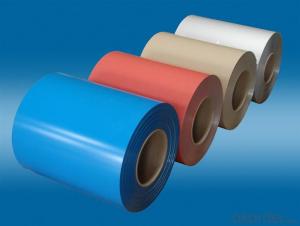Aluminium Coil Made in China High Quality
- Loading Port:
- China main port
- Payment Terms:
- TT or L/C
- Min Order Qty:
- 3 m.t.
- Supply Capability:
- 10000 m.t./month
OKorder Service Pledge
OKorder Financial Service
You Might Also Like
1. Specifications of Aluminum Coil
| Alloy Number | AA1xxx (AA1050, AA1060, AA1070, AA1100 etc.) AA3xxx (AA3003, AA3004, AA3005, AA3105 etc.) AA5xxx (AA5052, AA5083, AA5754 etc.) AA8xxx (AA8011, AA8006 etc.) |
| Temper | H14, H16, H18, H22, H24, H26, H32, O/F |
| Thickness | 0.2mm - 100mm |
| Width | 10mm- 2200mm |
| Standard | Standard: GB/T 3880-2006 |
Special Specification is available on customer’s requirements
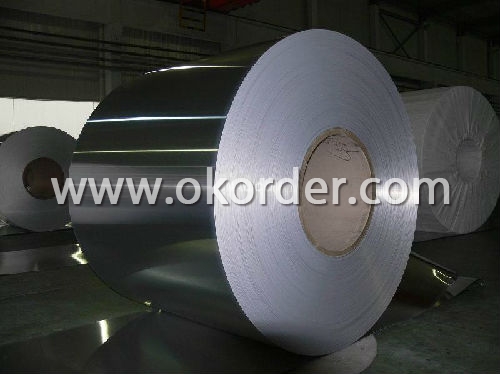
2. Usage/Applications of Aluminum Coils AA3003
Aluminum Coils has a wide variety of uses in the construction industry including aluminium siding and roofing. Sheet is also used widely in construction, decoration, transport applications and other various industrial filed, such as automobile body panels, airframes, curtain walls and the hulls of boats etc.
3. Packaging & Delivery of Aluminum Coils AA3003
Packaging: Seaworth package, water-proof paper wrapped inside, carton wrapped outside in wooden pallets.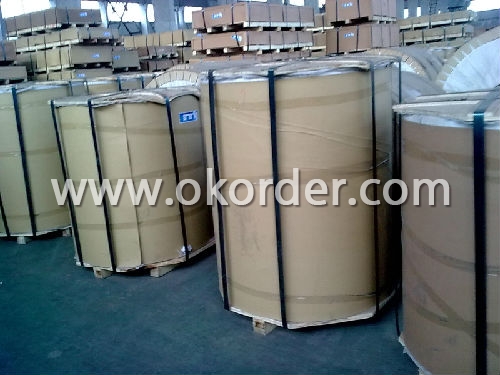
- Q:how tall is a crushed aluminium soda can compared to a non crushed one.i need measurements in centimeters please.ALSO!! AN IMAGE that actually has both of the two with the measurements would be SUPER HELPFUL
- I don't understand why you can't just measure a can, then crush it and measure it again. And with the number of cellphones kids have today, every one can take a picture. Why do we need to do this for you?
- Q:What are the potential applications of coil-anodized aluminum coils?
- Coil-anodized aluminum coils have a wide range of potential applications due to their durability, versatility, and aesthetic appeal. Some of the common applications include architectural cladding, roofing, signage, facade panels, interior decoration, automotive trim, and electronics casings. The anodized coating provides enhanced corrosion resistance, weatherability, and color stability, making it suitable for both indoor and outdoor use. Additionally, the ability to create various finishes and textures further expands the possibilities for using coil-anodized aluminum coils in different industries.
- Q:What are the different coil winding options available for aluminum coils?
- Aluminum coils offer several coil winding options to choose from. These options include: 1. Single-layer winding: This basic winding option involves winding the wire around the coil in a single layer. It is ideal for applications with limited space and the need for efficient cooling. 2. Double-layer winding: This option involves winding two layers of wire on top of each other. It provides improved heat dissipation and allows for higher power handling. 3. Concentric winding: With concentric winding, the wire is wound in concentric circles, each with a slightly different diameter. This type of winding reduces the overall size of the coil while maintaining high inductance. 4. Litz wire winding: Litz wire is composed of individually insulated strands. This winding option minimizes skin effect and reduces power loss due to high-frequency currents. It is commonly used in high-frequency applications. 5. Toroidal winding: Toroidal winding creates a circular shape for the wire, forming a toroidal coil. This type of winding offers better containment of the magnetic field and reduces electromagnetic interference. 6. Layered winding: Layered winding involves winding the wire in multiple insulated layers. It is used when a compact space requires a high number of turns. 7. Sectional winding: Sectional winding divides the coil into different sections and winds each section separately. This allows for better control over magnetic flux distribution and reduces losses. Each coil winding option has its own advantages and is suitable for different applications based on factors such as power handling capacity, size constraints, and frequency requirements.
- Q:What are the different joining methods for aluminum coils?
- There are several different joining methods for aluminum coils, depending on the specific application and desired strength of the bond. Some of the common joining methods for aluminum coils include: 1. Welding: Aluminum can be welded using different techniques such as TIG (Tungsten Inert Gas) welding, MIG (Metal Inert Gas) welding, or laser welding. Welding provides a strong and durable bond between the coils, ensuring structural integrity. 2. Brazing: Brazing involves melting a filler material, usually a copper-based alloy, to join two aluminum coils. This method is suitable for joining thin aluminum coils and provides a strong and leak-proof bond. 3. Adhesive bonding: Adhesive bonding is a non-destructive joining method that involves using a high-strength adhesive to bond the aluminum coils together. This method is often used when aesthetics and surface finish are crucial, as it does not require any visible welding or brazing marks. 4. Mechanical joining: Mechanical joining methods include techniques like riveting, clinching, and using fasteners like screws or bolts. These methods provide a reliable and easily reversible bond, making them suitable for applications where disassembly may be required. 5. Roll bonding: Roll bonding is a process where two or more aluminum coils are passed through a rolling mill under high pressure, resulting in the creation of a single composite coil. This method is commonly used for joining dissimilar metals or creating laminated structures with different alloy combinations. Each joining method has its advantages and limitations, and the choice of method depends on factors such as the desired strength, cost, production volume, and specific application requirements. It is important to consider these factors carefully to ensure the most suitable joining method is selected for aluminum coil applications.
- Q:Can aluminum coils be used in the production of solar panels?
- Aluminum coils are indeed suitable for the production of solar panels. Being a lightweight and durable material, aluminum brings numerous advantages to the manufacturing process. Its high conductivity and exceptional thermal properties enable efficient dissipation of heat. Furthermore, aluminum exhibits resistance to corrosion, a vital characteristic for solar panels as they encounter diverse weather conditions. Moreover, the cost-effectiveness of aluminum makes it a favored option in the solar industry. By employing aluminum coils in solar panel production, the performance, durability, and cost-effectiveness of these panels are greatly improved.
- Q:What causes tower after cutting aluminum coil
- Insulation aluminum coil will appear when the cooling bending phenomenon, reason is generally under the conditions of air cooling, the heat transfer coefficient of the aluminum coil insulation parts in contact with the air were flat, but because the wall thickness or different shapes, different parts of the heat dissipation rate is not balanced, resulting in thick wall or hollow tube heat faster than the thin Department of slow, resulting in insulating aluminum roll cooling occurs to the hollow part.
- Q:How are aluminum coils inspected for quality?
- To ensure the quality of aluminum coils, a series of rigorous tests and inspections are conducted. These inspections play a crucial role in meeting industry standards and specifications. Visual inspection is a commonly used method for examining aluminum coils. Trained inspectors carefully scrutinize the coils for visible defects like scratches, dents, or other physical imperfections that could impact the coil's quality. Specialized lighting and magnification equipment are used to achieve a thorough examination. Dimensional inspection is another important method. It involves measuring the dimensions of the coils and comparing them to specified tolerances. This ensures that the coils meet the required size and shape criteria. Coating inspection is also vital. It focuses on examining the aluminum coil's coating for uniformity, adhesion, and thickness. Specialized instruments are used to measure the coating thickness and ensure it meets the specified requirements. Furthermore, mechanical properties such as tensile strength, yield strength, and elongation are tested to evaluate the strength and durability of the aluminum coils. Samples from the coils are subjected to controlled stress, and their response is measured. Lastly, various non-destructive testing techniques are utilized to detect hidden defects or flaws that may not be visible to the naked eye. These techniques include ultrasonic testing, eddy current testing, and dye penetrant testing. They help identify internal defects like cracks or voids that could compromise the quality of the aluminum coils. In summary, a combination of visual inspections, dimensional measurements, coating inspections, mechanical property testing, and non-destructive testing techniques are employed to thoroughly inspect aluminum coils and ensure their suitability for use in industries like construction, automotive, and aerospace.
- Q:Are there any limitations to the maximum coil length of aluminum coils?
- Yes, there are limitations to the maximum coil length of aluminum coils. The maximum coil length depends on various factors such as the thickness and width of the aluminum coil, the strength and tensile properties of the aluminum alloy, the equipment used for coil processing, and the intended application of the coil. One limitation is the strength and ductility of the aluminum alloy being used. Aluminum alloys with higher strength and lower ductility may have limitations on the maximum coil length due to the risk of coil breakage or deformation during processing or handling. Another limitation is the equipment used for coil processing. The maximum coil length is often determined by the size and capabilities of the equipment used for slitting, cutting, or forming the coils. If the equipment has a limited capacity or is not designed for longer coils, it may not be able to handle or process longer lengths effectively. The intended application of the coil can also impose limitations on the maximum coil length. For example, if the coil is intended for transportation purposes, such as in the automotive industry, there may be restrictions on the maximum coil length based on the size and weight limitations of the vehicles. Additionally, logistical factors such as transportation and storage can also impose limitations on the maximum coil length. Longer coils may be more difficult to handle, transport, and store, which can increase the risk of damage or pose challenges in terms of logistics and space requirements. Therefore, while there is no specific universal limit to the maximum coil length of aluminum coils, it is essential to consider various factors such as alloy properties, equipment capabilities, application requirements, and logistical considerations to determine the practical limitations of coil length for a specific situation.
- Q:How do aluminum coils perform in high humidity environments?
- Aluminum coils perform well in high humidity environments due to their inherent resistance to corrosion. Unlike many other metals, such as iron or steel, aluminum does not rust when exposed to moisture. This makes it a suitable choice for applications where high humidity is a concern, such as air conditioning systems or refrigeration units. The corrosion resistance of aluminum is primarily due to the formation of a thin layer of aluminum oxide on its surface when exposed to oxygen. This oxide layer acts as a protective barrier against further oxidation, preventing the metal from deteriorating even in humid conditions. Moreover, the lightweight nature of aluminum allows for better heat transfer and energy efficiency in cooling systems. This property makes aluminum coils a popular choice as heat exchangers, as they can effectively transfer heat from the air or fluid passing through them. Additionally, aluminum coils are typically coated with a protective layer or treated with a corrosion-resistant coating to further enhance their performance in high humidity environments. These coatings provide an extra layer of protection against moisture and other corrosive elements, ensuring the longevity and reliability of the coils. In summary, aluminum coils are highly suitable for high humidity environments due to their resistance to corrosion and their efficient heat transfer properties. The combination of these factors makes them a reliable choice for various applications where moisture is a concern.
- Q:Are there any recycling programs for used aluminum coils?
- Yes, there are recycling programs available for used aluminum coils. Aluminum is highly recyclable and can be melted down and reused without losing its quality. Many recycling centers and scrap metal yards accept aluminum coils for recycling. Additionally, some HVAC (Heating, Ventilation, and Air Conditioning) companies have their own recycling programs for used aluminum coils, as they are commonly used in air conditioning systems. It is always recommended to check with your local recycling center or HVAC companies to inquire about specific recycling programs for used aluminum coils in your area.
1. Manufacturer Overview |
|
|---|---|
| Location | Henan, China |
| Year Established | 1996 |
| Annual Output Value | Above US$200 Million |
| Main Markets | Mid East;Eastern Europe;North America |
| Company Certifications | ISO 9001:2000;ISO 14001:2004;OHSAS 18001 |
2. Manufacturer Certificates |
|
|---|---|
| a) Certification Name | |
| Range | |
| Reference | |
| Validity Period | |
3. Manufacturer Capability |
|
|---|---|
| a)Trade Capacity | |
| Nearest Port | Shanghai |
| Export Percentage | 30%-50% |
| No.of Employees in Trade Department | 21-50 People |
| Language Spoken: | English;Chinese |
| b)Factory Information | |
| Factory Size: | Above 100,000 square meters |
| No. of Production Lines | Above 10 |
| Contract Manufacturing | OEM Service Offered;Design Service Offered |
| Product Price Range | Average |
Send your message to us
Aluminium Coil Made in China High Quality
- Loading Port:
- China main port
- Payment Terms:
- TT or L/C
- Min Order Qty:
- 3 m.t.
- Supply Capability:
- 10000 m.t./month
OKorder Service Pledge
OKorder Financial Service
Similar products
New products
Hot products
Hot Searches
Related keywords


